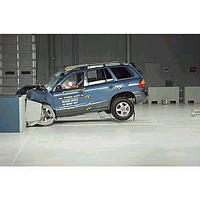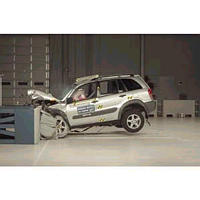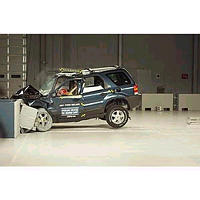Crash Test Results: Performances of Three Small SUVs Vary

HYUNDAI SANTA FE-KABOOM

TOYOTA RAV4-KABOOM

FORD ESCAPE-KABOOM
Hyundai Santa Fe Is Tops, But New Ford Escape Disappoints
Only one of three small sport utility vehicle designs, new for 2001, earns a good overall rating based on performance in a 40 mph frontal offset crash test conducted by the Insurance Institute for Highway Safety. The Hyundai Santa Fe earns this distinction, going to the top of the list of 10 current small SUV designs the Institute has evaluated. The other two new small SUVs earn lower ratings -- the Toyota RAV4 (redesigned for 2001) is acceptable, and the Ford Escape (a new model for 2001) is marginal.
Best Performer
The 2001 Hyundai Santa Fe held up very well in the Institute's 40 mph crash test. There wasn't much intrusion into the occupant compartment, so the space around the driver dummy was maintained well.
"The only problem was that the dummy's head hit the B-pillar hard during rebound from the airbag," Institute president Brian O'Neill points out. "This wasn't indicative of a serious head injury, but it did prevent the Santa Fe from earning a 'best pick' designation. As it is, the crashworthiness of the Santa Fe is good."
New RAV4 Design is an Improvement
This is the second time the Institute has tested a RAV4 in the 40 mph frontal offset impact. An earlier design (1998 model) was rated marginal. The new 2001 model tested better.
"In particular, the structural performance improved. But there still is room for improvement. The dummy's head hit the steering wheel through the airbag, and there was a possibility of injury to both lower legs," O'Neill says.
'Disappointing' Debut of Ford Escape
There was moderate to major intrusion into the driver footwell area of the 2001 Ford Escape during the Institute's 40 mph crash test. Because of this, there was a high likelihood of right leg injury. The dummy's head struck the steering wheel through the airbag, and then during rebound its head struck the B-pillar. Both head impacts were hard.
"Overall this is a disappointing showing," O'Neill says. "The Escape was Ford's joint program with Mazda, and clearly this cooperative effort didn't produce a particularly crashworthy design."
Comparison with Passenger Cars
Small SUVs weigh about the same as midsize cars. This means their crash test results can be compared directly (results shouldn't be compared among vehicles with large weight differences).
"These comparisons aren't favorable to the group of small SUVs, which only includes two good performers," O'Neill also says.
The Institute's crashworthiness evaluations are based primarily on results of the frontal offset crash test. Each vehicle's overall evaluation (please download ratings list from Assets column) is based on three aspects of performance: measurements of occupant compartment intrusion, injury risk measures from a Hybrid III dummy positioned in the driver seat, and analysis of slow-motion film to assess how well the restraint system controlled dummy movement during the test.


